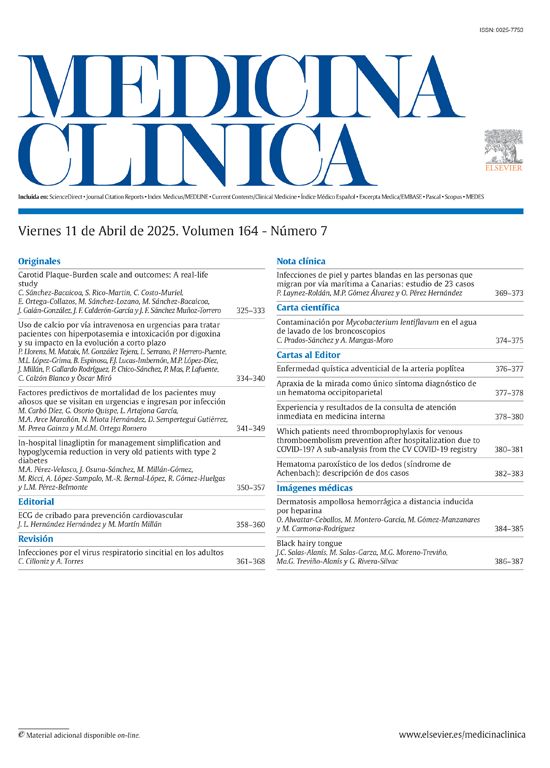Th/To autoantibody may be relevant in evaluating patients with interstitial lung disease (ILD) because the clinical diagnosis of systemic sclerosis (SSc) may not be evident. The study's objective was to describe manifestations and evolution of pulmonary function in a cohort of ILD patients positive for Th/To autoantibodies.
MethodsILD patients positive for anti-Th/To autoantibody were enrolled in this protocol. Baseline clinical features were registered, and survival analysis was performed to identify risk factors associated with worse survival.
ResultsFifty-two patients positive for anti-Th/To autoantibodies with ILD were included. Only 21% of the patients fulfilled the ACR/EULAR 2013 systemic sclerosis classification criteria, and 63.4% fulfilled the IPAF ATS/ERS 2015 criteria. Twenty-five percent of the patients died during follow-up. Respiratory failure was the principal cause of death. Twenty-nine patients (56%) were positive for other hallmark SSc autoantibodies. The most frequent HRCT pattern was nonspecific interstitial pneumonia (NISP). Survival was strongly associated to the systolic pulmonary arterial pressure (sPAP), male sex and the extent of fibrosis in HRCT; besides, patients positive for other hallmark SSc autoantibodies had worse survival compared to those positive only to anti-Th/To. Seventy-six percent of them behaved as fibrotic progressive pulmonary disease, with an absolute decline of the FVC of at least 5%.
ConclusionsOnly a small proportion of ILD patients positive for Th/To meet the criteria to be classified as SSc; however, most met criteria for IPAF. A high proportion of patients behave as progressive fibrotic pulmonary disease. Survival is associated with sPAP, the extent of lung disease, and the presence of other hallmark SSc autoantibodies.
El autoanticuerpo Th/To puede ser relevante en la evaluación de pacientes con enfermedad pulmonar intersticial (EPI) debido a que el diagnóstico clínico de esclerosis sistémica (ES) puede no ser evidente. El objetivo del estudio fue describir las manifestaciones clínicas y la evolución de la función pulmonar en una cohorte de pacientes con EPI positivos para autoanticuerpos Th/To.
MétodosEn este protocolo se inscribieron pacientes con EPI positivos para autoanticuerpos anti-Th/To. Se registraron las características clínicas iniciales y se realizó un análisis de supervivencia para identificar los factores de riesgo asociados con una peor supervivencia.
ResultadosSe incluyeron 52 pacientes positivos para autoanticuerpos anti-Th/To con EPI. Solo el 21% de los pacientes cumplió los criterios de clasificación para esclerosis sistémica ACR/EULAR 2013 y el 63,4% cumplió los criterios de neumonía con características autoinmunes ATS/ERS 2015. El 25% de los pacientes falleció durante el seguimiento. La insuficiencia respiratoria fue la principal causa de muerte. Veintinueve pacientes (56%) dieron positivo para otros autoanticuerpos distintivos de ES. El patrón más frecuente en la tomografía computarizada de alta resolución (TCAR) fue la neumonía intersticial inespecífica. La supervivencia estuvo estrechamente asociada con la presión arterial pulmonar sistólica (PAPs), el sexo masculino y la extensión de fibrosis en la TCAR. Además, los pacientes positivos para otros autoanticuerpos distintivos de ES tuvieron una peor supervivencia en comparación con aquellos positivos solo para anti-Th/To. El 66% de ellos se comportaron como enfermedad pulmonar fibrótica progresiva, con una disminución absoluta de la capacidad vital forzada de al menos el 5%.
ConclusionesSolo una pequeña proporción de pacientes con EPI positivos para Th/To cumplieron con los criterios para ser clasificados como ES. Sin embargo, la mayoría cumplió con los criterios de neumonía con características autoinmunes. Una alta proporción de pacientes se comportó como enfermedad pulmonar fibrótica progresiva. La supervivencia se asocia con PAPs, con la extensión de la enfermedad pulmonar y conla presencia de otros autoanticuerpos característicos de ES.











